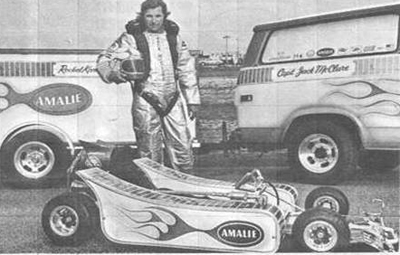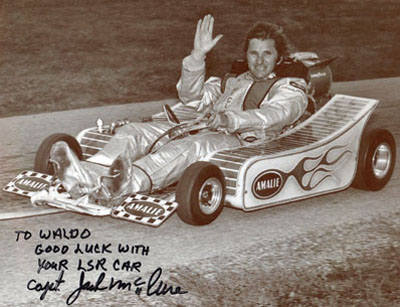This not exactly a race car, as it was an exhibition vehicle, but what a little piece of craziness it was! This tiny terror made Jack McClure a living for three or four years in the early 1970s and, amazingly, he never crashed it.
Although he made most of his money and built his fame in the 1970s, McClure had rocket go karts way back in 1964. Those were truly go-karts, basic kit karts with Turbonique rocket motors mounted to the back of them. There’s a famous photo of what looks to be McClure on his little go kart beating the front motored Top Fueler of Tommy Ivo. As it turns out the track manager staged the photo by placing McClure (in a busted kart) about 100 feet ahead of Ivo. When Ivo launched off smoking the tires, the camera man took the shot and got the image. Ivo still likes to rib the parties involved to this day.
That initial kart with the two 300-pound-thrust Turbonique engines would run about 150 mph in the quarter mile. It had to be scary as hell. Aside from the obvious driving dangers there was also the possibility that the Turbonique engines would explode and kill you.
The NHRA banned the rocket go-kart acts fairly quick, concerned that they’d be using a squeegee to clean up after one that wrecked. This was not that big a deal thought as the AHRA, IHRA, and various unsanctioned tracks had no problems booking Captain Jack into their shows.
After a break of a few years, McClure returned to the scene with a kart that he designed himself and had put together by a guy from Tampa, Florida, named Glenn Blakely. This was a lay-down kart that at first sported a 1,000-pound hydrogen peroxide rocket motor. With that engine, the missile kart was good for clockings in the high 180s. McClure thought 200 mph would be the ultimate number to get people into the stands, so he plunked a 1500-pound motor into the contraption.
Incidentally, McClure used Velcro to lock himself into the kart and actually wore a parachute on his back in the event that he was ejected from the kart, which luckily for him, never happened.
With the 1500-pound-thrust engine, the kart would go 6s in the quarter mile and well over 215 mph. It was a show stopper and soon he was booking up to 100 shows a year at about $800.00 a pop. It only cost him about 90 bucks a run to make laps in the kart and the initial built cost was short money as well. Outside of risking life and limb on every run, Captain Jack was sitting on a pile of easy money.
After the supplies of pure hydrogen peroxide began to dry up and the cost of operating the kart got too great he decided to sell it and get out of the business. We’ve heard that he went back to fishing (hence the “Captain” moniker).




























